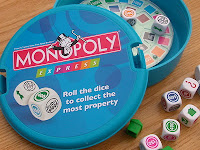:strip_icc()/pic742553.jpg) |
| (c) Queen Games - used by permission |
In my last post, I mentioned that I'd picked up Robber Knights as an after-thought in the FunAgain Games spring cleaning sale. But the game that I snapped up with deliberate intent in that sale as soon as I saw it was Samarkand: Routes to Riches (designers David V.H. Peters and Harry Wu, artist Jo Hartwig, publisher Queen Games). I had put this game high on my wish list after reading good reviews and then realizing that its designers included Harry Wu, inventor of one of my very favorite games, Chicago Express.
As I read the rules the first time, I feared that S:RtR would turn out to be a warmed-over version of CE. Camels replace trains, merchant families replace railroad companies, ... was it just a variation on a theme? But now that Kathy and I have a played it through a second time, I realize that S:RtR is a different game altogether, one in which a few similar mechanics are combined in some altogether new ways to make for a completely different decision space.
Each turn a player may take one of two actions: Pay a dowry to marry into a merchant family, or expand the trade routes of a merchant family into which he or she has already married. Merchant families form trade relationships when their trade routes meet for the first time. Players earn points for forming trade relationships involving families into which they are married. Among other things, points are also scored for trade routes that reach trade locations corresponding to goods whose cards they hold - with a bonus for being married into the family of such a trade route.
 |
| Cocktails and camel trails |
The result is a game that encourages network-building among trading families, with a premium on being married into the right families and on initiating the trade relationships. I'm reminded of an article (or podcast perhaps) I came across some weeks ago that discussed the transitional course of some games, particularly network-building games, where things seem to happen in isolation early in the game and then reach a kind of tipping point in which every move seems to create another connection. Acquire is an example of such a game, in which hotel tiles are added in bits and pieces around the board early on, until before you know it, medium-sized hotels are taking over other hotels and forming huge hotels over the course of just a few turns. Ticket to Ride can be the same way, as train routes suddenly start to collide. It's almost avalanche-like in the way the game accelerates into a phase-transition from the early stages to the end-game dynamic.
 |
| Dromedaries dot the landscape of the Middle East |
The significance of this network-building effect is that players need to be alert to the fact that strategy changes drastically as the tipping point is approached. In our game this afternoon, I played very conservatively early on, not wanting to deplete the resources of the families into which I'd married by expanding the camel routes too rapidly. I thought I had a sound, methodical approach to the game. Kathy and I developed trade routes practically on opposite sides of the board, and I actually worried at one point that we might not interact at all, and that the game would be very boring.
 |
| Kathy's mercantile in-laws |
That changed rapidly when I married into the Alan (yellow) family, where Kathy already had an interest. Suddenly neither of us could take for granted where the camels of the Alan family would go. She soon responded by marrying into the Hun (black) family that had been my focus area for much of the early game. Meanwhile, she also developed a number of trade relationships among her own families and snapped up goods tokens at every opportunity. She made the point-gathering transition much faster than I did, and before long she was moving to trigger game-end. Suddenly I found myself scrambling to grab points that I thought I'd be able to accumulate at my leisure.
The end result was that Kathy beat me in every category of victory points with a final score of 83 to 61. Clearly I had been out-married, out-traded, out-cameled, and out-cashed. We both had a great time with Samarkand, and next time I will be watching out much more closely for the network avalanche.
/pic159125.jpg)

/pic195080.jpg)

/pic896670.jpg)




















/pic1170672.jpg)
/pic403502.jpg)




